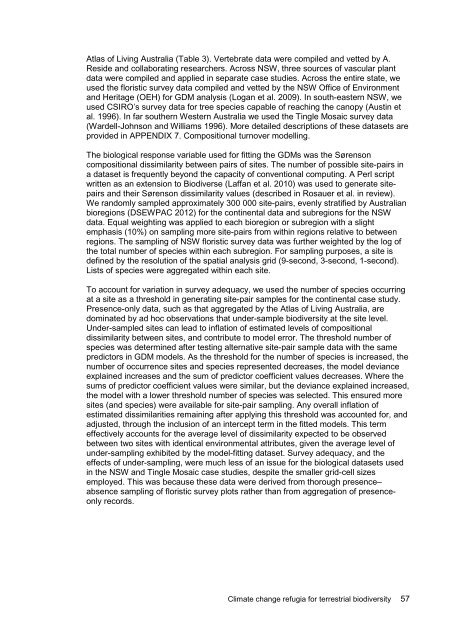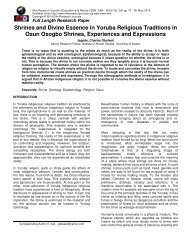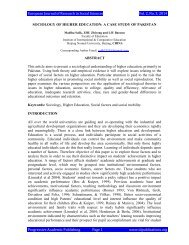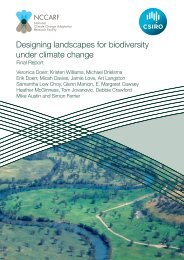Williams-Climate-change-refugia-for-terrestrial-biodiversity_0
Williams-Climate-change-refugia-for-terrestrial-biodiversity_0
Williams-Climate-change-refugia-for-terrestrial-biodiversity_0
Create successful ePaper yourself
Turn your PDF publications into a flip-book with our unique Google optimized e-Paper software.
Atlas of Living Australia (Table 3). Vertebrate data were compiled and vetted by A.<br />
Reside and collaborating researchers. Across NSW, three sources of vascular plant<br />
data were compiled and applied in separate case studies. Across the entire state, we<br />
used the floristic survey data compiled and vetted by the NSW Office of Environment<br />
and Heritage (OEH) <strong>for</strong> GDM analysis (Logan et al. 2009). In south-eastern NSW, we<br />
used CSIRO’s survey data <strong>for</strong> tree species capable of reaching the canopy (Austin et<br />
al. 1996). In far southern Western Australia we used the Tingle Mosaic survey data<br />
(Wardell-Johnson and <strong>Williams</strong> 1996). More detailed descriptions of these datasets are<br />
provided in APPENDIX 7. Compositional turnover modelling.<br />
The biological response variable used <strong>for</strong> fitting the GDMs was the Sørenson<br />
compositional dissimilarity between pairs of sites. The number of possible site-pairs in<br />
a dataset is frequently beyond the capacity of conventional computing. A Perl script<br />
written as an extension to Biodiverse (Laffan et al. 2010) was used to generate sitepairs<br />
and their Sørenson dissimilarity values (described in Rosauer et al. in review).<br />
We randomly sampled approximately 300 000 site-pairs, evenly stratified by Australian<br />
bioregions (DSEWPAC 2012) <strong>for</strong> the continental data and subregions <strong>for</strong> the NSW<br />
data. Equal weighting was applied to each bioregion or subregion with a slight<br />
emphasis (10%) on sampling more site-pairs from within regions relative to between<br />
regions. The sampling of NSW floristic survey data was further weighted by the log of<br />
the total number of species within each subregion. For sampling purposes, a site is<br />
defined by the resolution of the spatial analysis grid (9-second, 3-second, 1-second).<br />
Lists of species were aggregated within each site.<br />
To account <strong>for</strong> variation in survey adequacy, we used the number of species occurring<br />
at a site as a threshold in generating site-pair samples <strong>for</strong> the continental case study.<br />
Presence-only data, such as that aggregated by the Atlas of Living Australia, are<br />
dominated by ad hoc observations that under-sample <strong>biodiversity</strong> at the site level.<br />
Under-sampled sites can lead to inflation of estimated levels of compositional<br />
dissimilarity between sites, and contribute to model error. The threshold number of<br />
species was determined after testing alternative site-pair sample data with the same<br />
predictors in GDM models. As the threshold <strong>for</strong> the number of species is increased, the<br />
number of occurrence sites and species represented decreases, the model deviance<br />
explained increases and the sum of predictor coefficient values decreases. Where the<br />
sums of predictor coefficient values were similar, but the deviance explained increased,<br />
the model with a lower threshold number of species was selected. This ensured more<br />
sites (and species) were available <strong>for</strong> site-pair sampling. Any overall inflation of<br />
estimated dissimilarities remaining after applying this threshold was accounted <strong>for</strong>, and<br />
adjusted, through the inclusion of an intercept term in the fitted models. This term<br />
effectively accounts <strong>for</strong> the average level of dissimilarity expected to be observed<br />
between two sites with identical environmental attributes, given the average level of<br />
under-sampling exhibited by the model-fitting dataset. Survey adequacy, and the<br />
effects of under-sampling, were much less of an issue <strong>for</strong> the biological datasets used<br />
in the NSW and Tingle Mosaic case studies, despite the smaller grid-cell sizes<br />
employed. This was because these data were derived from thorough presence–<br />
absence sampling of floristic survey plots rather than from aggregation of presenceonly<br />
records.<br />
<strong>Climate</strong> <strong>change</strong> <strong>refugia</strong> <strong>for</strong> <strong>terrestrial</strong> <strong>biodiversity</strong> 57






